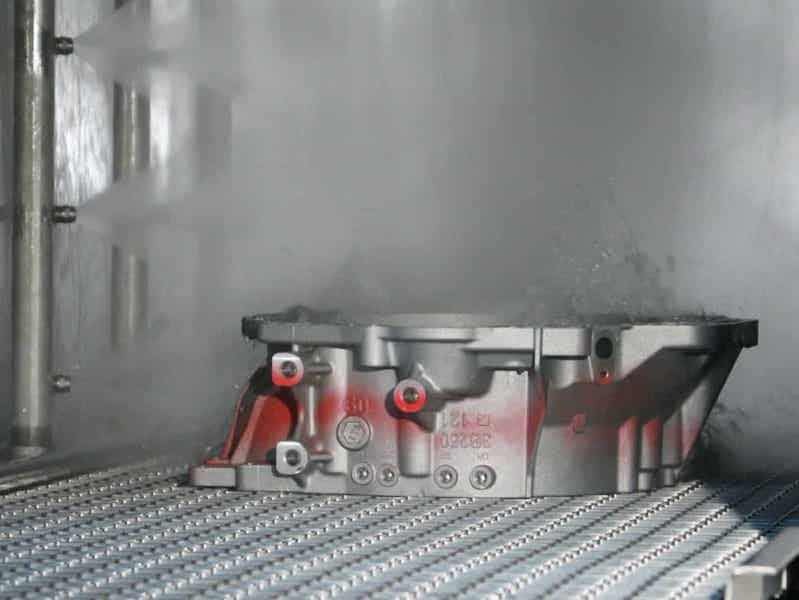When we see clients, one of the first questions we ask is: Why?
 Barbara and Ed Kanegsberg, Professor Darren WilliamsWhy are you cleaning the part, component, or product? How did you come to choose the cleaning process and cleaning chemicals? Why are you changing the process? Why are you looking at a particular type of new cleaning equipment? We need to determine the cleaning and product performance goals. This involves understanding the stated goals and determining the actual goals.
Barbara and Ed Kanegsberg, Professor Darren WilliamsWhy are you cleaning the part, component, or product? How did you come to choose the cleaning process and cleaning chemicals? Why are you changing the process? Why are you looking at a particular type of new cleaning equipment? We need to determine the cleaning and product performance goals. This involves understanding the stated goals and determining the actual goals.
Once you understand the goals, it is easier to identify barriers. Because communication is perhaps the most difficult barrier to effective manufacturing, understanding the “why” helps in avoiding costly mistakes.
Soil is Matter Out of Place
As many of you are aware, soil is matter out of place. Cleaning is removing soil from the substrate or part being cleaned. In Table 1, there are a few examples that might be considered soils, depending on the product and the end-use requirements.
Table 1. A non-exhaustive list of soils
| Classic lubricants | Coolants |
| Tallow | Packing oils |
| Water-based lubricants | Particles |
| Bio-based lubricants | Polishing grit |
| Greases | 3D powders |
| Lapping/polishing compounds | Chips/metal fines |
Is Cleaning Necessary?
Don’t clean if you don’t have to. Very often, cleaning is a positive and necessary activity, but it is an inherently disruptive activity. Some companies have a policy that requires cleaning of all incoming parts. If incoming parts are already clean enough, the added cleaning step could be counterproductive. Cleaning can introduce residue from the cleaning agent, which can itself be soil. The cleaning process – the chemicals and the cleaning forces – can damage the product. Cleaning is not free. Equipment costs, process design, process monitoring, and labor all cost money.
Where cleaning is necessary, understand the function of the cleaning process steps. The general goal of any cleaning process is to adequately remove the soil without damage or undesirable modification of the surface of the substrate. Most, but not all, cleaning processes involve washing, rinsing, and drying. Each step requires specific equipment. Each step requires a separate and coordinated process design. Each step requires separate and coordinated process control.
Begin With the End in Mind
Current wisdom implores us to always begin with the end in mind. But what does that even mean? There can be quality goals like cleanliness levels or a decrease in the defect rate. Improved throughput is a plus. Is the cleanliness goal correct? Is it achievable? Is it arbitrary? If the goal is arbitrary and unreasonable, can the goal be changed? Some goals are externally enforced.
Picture a supplier of high-end process equipment. For some reason, the customer demands a product with a very low level of sub-micron particle contamination on process equipment. Perhaps the requirement has nothing to do with product quality from your perspective. Even with a large capital equipment investment and careful process control, it may be difficult or impossible to achieve. Heaven forbid that someone on the process development team for the supplier be allowed to discuss the rationality of the requirement with the customer! Instead, everyone is told, “Do not ask why, just fix the problem and meet the spec.” Everyone scurries around in a futile attempt to achieve this level of sub-micron contamination.
Eventually, someone at the supplier realizes the futility of the effort and allows their people to talk with the people at the customer. In our experience, unrealistic cleaning requirements are often imposed without an understanding of what might be required to meet them. Since we are involved in chemistry, let’s pick on a mechanical engineer! Perhaps the M.E. arbitrarily took a cleanliness spec (say, one for precision optics) and plopped it into the requirements for the large process equipment. The M.E. figured that the more stringent the cleaning requirements, the better the product quality, and the process engineers could somehow make it work.
If all goes well, the supplier can communicate cleaning requirements to the customer – especially to the M.E. More appropriate, achievable cleanliness standards can be agreed on. For example, the customer requires that a hood ornament meet ISO 16232 because it is an automotive part. You ask why? You then make the counteroffer that this spec addresses a)moving parts that could experience wear from particles or b) small holes that could be clogged by particles. You mention that the part has no moving parts or small holes and explain the added cost of additional inspection. You both decide that the ISO spec is not necessary. We find that success in such situations involves information exchange and technical discussion. This can only happen if the supplier understands what must be accomplished. It involves tactfully asking “why”.
Beginning with the end in mind does not necessarily mean setting a goal and figuring out how high to jump to meet that goal. It means understanding what the cleaning process is meant to accomplish and how to determine if appropriate product quality is met.
A Phenomenal Critical Cleaning Star
Being a critical cleaning superstar means always asking questions and always wondering why. Why are you removing the soil? What processes should you invest in? How will non-technical issues, events not under your control, impact cleaning? Safety and environmental requirements change ever- more rapidly. Cleaning agents may become less available due to the plethora of confusing regulations. Regulations impact decisions made by businesses, including providers of cleaning agents and cleaning equipment, as well as components suppliers. Manufacturing requirements change rapidly. The cleaning processes that are favored today could be prohibited tomorrow, so asking “why” is an ongoing activity.
Reference
- ISO 16232”2018 Road Vehicles – Cleanliness of Components and Systems; https://www.iso.org/standard/70267.html
Barbara and Ed Kanegsberg founded BFK Solutions in 1994 as a critical cleaning consulting service and the go-to resource to make cleaning, surface quality, and contamination problems go away, or — even better — to avoid problems in the first place. Barbara, widely known as “The Cleaning Lady,” is an expert and trusted adviser in critical cleaning. Ed is known as “The Rocket Scientist,” and they write Clean Source, an approximately monthly e-newsletter that provides practical ideas to improve cleaning, contamination control, and product quality. They are co-editors of and contributors to the acclaimed two-volume “Handbook for Critical Cleaning,” CRC/Taylor & Francis, 2011. Visit https://bfksolutions.com
Darren Williams is a Professor of Physical Chemistry at Sam Houston State University; Leader of the Cleaning Research Group; co-chair of the Product Quality Cleaning Workshops; author of articles and book chapters on cleaning verification and cleaner formulation; and performs cleaning trials and formulates cleaning chemistries at the university for external clients. williams@shsu.edu



































